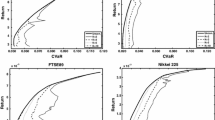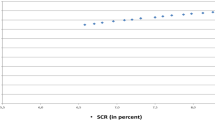Abstract
Multi-portfolio optimization problems and the incorporation of marginal risk contribution constraints have recently received a sustained interest from academia and financial practitioners. We propose a class of new stochastic risk budgeting multi-portfolio optimization models that impose portfolio as well as marginal risk constraints. The models permit the simultaneous and integrated optimization of multiple sub-portfolios in which the marginal risk contribution of each individual security is accounted for. A risk budget defined with a downside risk measure is allocated to each security. We consider the two cases in which the asset universes of the sub-portfolios are either disjoint (diversification of style) or overlap (diversification of judgment). The proposed models take the form of stochastic programming problems and include each a probabilistic constraint with multi-row random technology matrix. We expand a combinatorial modeling framework to represent the feasible set of the chance constraints first as a set of mixed-integer linear inequalities. The new reformulation proposed in this paper is much sparser than previously presented reformulations and allows the efficient solution of problem instances that could not be solved otherwise. We evaluate the efficiency and scalability of the proposed method that is general enough to be applied to general chance-constrained optimization problems. We conduct a cross-validation study via a rolling-horizon procedure to assess the performance of the models, and understand the impact of the parameters and diversification types on the portfolios.


Similar content being viewed by others
References
Basak, S., & Shapiro, A. (2001). Value-at-risk-based risk management: Optimal policies and asset prices. Review of Financial Studies, 14(2), 371–405.
Benati, S., & Rizzi, R. (2007). A mixed integer linear programming formulation of the optimal mean/value-at-risk portfolio problem. European Journal of Operational Research, 176(1), 423–434.
Bertsimas, D., Darnell, C., & Soucy, R. (1999). Portfolio construction through mixed-integer programming at Grantham, Mayo, Van Otterloo and Company. Interfaces, 29(1), 49–66.
Blake, D., Rossi, A. G., Timmermann, A., Tonks, I., & Wermers, R. (2013). Decentralized investment management: Evidence from the pension fund industry. The Journal of Finance, 68(3), 1133–1178.
Bonami, P., & Lejeune, M. A. (2009). An exact solution approach for portfolio optimization problems under stochastic and integer constraints. Operations Research, 57, 650–670.
Boros, E., Hammer, P. L., Ibaraki, T., & Kogan, A. (1997). Logical analysis of numerical data. Mathematical Programming, 79, 163–190.
Boudt, K., Peterson, B., & Croux, C. (2008). Estimation and decomposition of downside risk for portfolios with non-normal returns. Journal of Risk, 11(2), 79–103.
Boudt, K., Carl, P., & Peterson, B. (2013). Asset allocation with conditional value-at-risk budgets. Journal of Risk, 15(3), 39–68.
Bruder, B., & Roncalli, T. (2013). Managing risk exposures using the risk parity approach. Tech. rep., LYXOR Research Report.
Charnes, A., & Cooper, W. W. (1959). Chance-constrained programming. Management Science, 6(1), 73–79.
Chopra, V. K., & Ziemba, W. T. (1993). The effect of errors in means, variances, and covariances on optimal portfolio choice. The Journal of Portfolio Management, 19(2), 6–11.
Cornuejóls, G., & Tútúncú, R. (2007). Optimization methods in finance. New York: Cambridge University Press.
Crama, Y., & Hammer, P. L. (2011). Boolean functions—Theory, algorithms and applications. New York: Cambridge Press University.
DeMiguel, V., Garlappi, L., Nogales, F. J., & Uppal, R. (2009). A generalized approach to portfolio optimization: Improving performance by constraining portfolio norms. Management Science, 55(5), 798–812.
Elton, E. J., & Gruber, M. J. (2004). Optimum centralized portfolio construction with decentralized portfolio management. Journal of Financial and Quantitative Analysis, 39(3), 481–494.
Fabozzi, F., Huang, D., & Zhou, G. (2010). Robust portfolios: Contributions from operations research and finance. Annals of Operations Research, 176, 191–220.
Filomena, T. P., & Lejeune, M. A. (2012). Stochastic portfolio optimization with proportional transaction costs: Convex reformulations and computational experiments. Operations Research Letters, 40(3), 212–217.
Filomena, T. P., & Lejeune, M. A. (2014). Warm-start heuristic for stochastic portfolio optimization with fixed and proportional transaction costs. Journal of Optimization Theory and Applications, 161(1), 308–329.
Gaivoronski, A. A., & Pflug, G. (2005). Value-at-risk in portfolio optimization: Properties and computational approach. Journal of Risk, 7(2), 1–31.
Goh, J. W., Lim, K. G., Sim, M., & Zhang, W. (2012). Portfolio value-at-risk optimization for asymmetrically distributed asset returns. European Journal of Operational Research, 221(2), 397–406.
Hsia, Y., Wu, B., & Li, D. (2014). New reformulations for probabilistically constrained quadratic programs. European Journal of Operational Research, 233(3), 550–556.
Jaeger, R. A., Rausch, M. A., & Foley, M. (2010). Multi-horizon investing: A new paradigm for endowments and other long-term investors. The Journal of Wealth Management, 13(1), 32–42.
Jorion, P. (2001). Value at risk: The new benchmark for managing financial risk (2nd ed.). New York: McGraw-Hill.
Kataoka, S. (1963). A stochastic programming model. Econometrica, 31(12), 181–196.
Kogan, A., & Lejeune, M. A. (2014). Threshold Boolean form for joint probabilistic constraints with random technology matrix. Mathematical Programming, 147(1–2), 391–427.
Krokhmal, P., Palmquist, J., & Uryasev, S. (2001). Portfolio optimization with conditional value-at-risk objective and constraints. Journal of Risk, 4, 43–68.
Lai, T. L., Xing, H., & Chen, Z. (2011). Mean-variance portfolio optimization when means and covariances are unknown. The Annals of Applied Statistics, 5(2A), 798–823.
Lee, J., & Prépoka, A. (2012). Properties and calculation of multivariate risk measures: MVaR and MCVaR. Rutcor Research Report.
Lejeune, M. A. (2012a). Pattern-based modeling and solution of probabilistically constrained optimization problems. Operations Research, 60(6), 1356–1372.
Lejeune, M. A. (2012b). Pattern definition of the \(p\)-efficiency concept. Annals of Operations Research, 200(1), 23–36.
Lejeune, M. A., & Shen, S. (2014). Boolean formulations for multi-objective probabilistically constrained programs with variable risk. Working Paper.
Markowitz, H. M. (1952). Portfolio selection. Journal of Finance, 7, 77–91. March.
Markowitz, H. M. (1959). Portfolio selection: Efficient diversification of investments. New York: Wiley.
Morgan, J. P. (1996). RiskMetrics: Technical document. New York: Morgan Guaranty Trust Company of New York.
Morgan, J. P. (1997). CreditMetrics: Technical Document. New Yok: JP Morgan & Co.
O’Cinneide, C., Scherer, B., & Xu, X. (2006). Pooling trades in a quantitative investment process. The Jounral of Portfolio Management, 32(4), 33–43.
Ogryczak, W., & Ruszczyński, A. (1999). From stochastic dominance to mean-risk models: Semi-deviations as risk measures. European Journal of Operational Research, 116, 33–50.
Pagnoncelli, B. K., Ahmed, S., & Shapiro, A. (2009). Sample average approximation method for chance constrained programming: Theory and applications. Journal of Optimization Theory and Applications, 142(2), 399–416.
Prékopa, A. (2012). Multivariate value at risk and related topics. Annals of Operations Research, 193, 49–69.
Rockafellar, R. T., & Uryasev, S. (2000). Optimization of conditional value-at-risk. Journal of Risk, 2, 21–42.
Rockafellar, R. T., & Uryasev, S. (2002). Conditional value-at-risk for general loss distributions. Journal of Banking & Finance, 26(7), 1443–1471.
Roncalli, T. (2013). Introduction to risk parity and budgeting. Boca Raton: CRC Financial Mathematics Series.
Roy, A. D. (1952). Safety first and the holding of assets. Econometrica: Journal of the Econometric Society, 20(3), 431–449.
Savelsbergh, M. W. P., Stubbs, R. A., & Vandenbussche, D. (2010). Multiportfolio optimization: A natural next step. In J. B. Guerard (Ed.), Handbook of portfolio construction (pp. 565–581). Berlin: Springer.
Sharpe, W. F. (1981). Decentralized investment management. Journal of Finance, 36, 217–234.
Standard & Poor’s (S&P) and Morgan Stanley Capital International (MSCI). (2002). Global industry classification standard—A guide to the GICS methodology.
Stubbs, R. A., & Vandenbussche, D. (2009). Multi-portfolio optimization and fairness in allocation of trades.Tech. rep., Axioma Research Paper.
Unger, A. (2015). The use of risk budgets in portfolio optimization. Berlin: Springer.
Vardharaj, R., & Fabozzi, F. J. (2007). Sector, style, region: Explaining stock allocation performance. Financial Analysts Journal, 63(3), 59–70.
Wang, M. Y. (1999). Multiple-benchmark and multiple-portfolio optimization. Financial Analyst Journal, 55(1), 63–72.
Wozabal, D. (2012). Value-at-risk optimization using the difference of convex algorithm. OR Spectrum, 34(4), 861–883.
Yoda, K., & Prékopa, A. (2010). Optimal portfolio selection based on multiple value at risk constraints. Rutcor Research Report.
Zheng, X., Sun, X., Li, D., & Cui, X. (2012). Lagrangian decomposition and mixed-integer quadratic programming reformulations for probabilistically constrained quadratic programs. European Journal of Operational Research, 221(1), 38–48.
Zhu, S., Li, D., & Sun, X. (2010). Portfolio selection with marginal risk control. Journal of Computational Finance, 14(1), 3–28.
Author information
Authors and Affiliations
Corresponding author
Appendices
Appendix
1.1 Appendix 1: Example for combinatorial reformulation method
Example 1
Consider the following stochastic multi-portfolio optimization problem based on formulation M1. Assets 1 and 2 (resp., 1 and 3) are considered for possible inclusion in sub-portfolio 1 (resp., 2). The random vector \(\xi \) of asset returns accepts 10 equally likely realizations \(l_j^k, k \in {\varOmega }= \{1,\ldots ,10\}\). The loss realizations (expressed in percentage of asset prices) and probability distribution are shown in Table 5. The notation F refers to the cumulative trivariate probability distribution of the asset returns, while \(F_j, j\in J\) is the cumulative marginal probability distribution of asset j.
1.2 Sufficient-equivalent set of cut points and binarization
In our example, the sufficient-equivalent set \(C^e(p)\) includes seven cut points.
The binary images of the recombinations obtained with \(C^e(p)\) are shown in Table 6. The truth table of the pdBf \(g\left( \bar{{\varOmega }}_B^+(p), \bar{{\varOmega }}_B^-(p) \right) \) is displayed in the central part of Table 6.
1.3 Reformulations of threshold tight minorant (27)–(29)
In our example, the system of inequalities (27)–(29) reads:
1.4 Reformulations of threshold tight minorant (31)–(34)
In our example, the system of inequalities (31)–(34) reads:
1.5 Feasible set with DMR-0 reformulation
The reformulations for the feasible set of the chance constraint defined by (50)–(54) reads:
1.6 Feasible set with DRM1 reformulation
The reformulations for the feasible set of the chance constraint defined by (42)–(46) reads:
Appendix 2: Asset universe
See Table 7.
Appendix 3: Parameters for computational study
See Table 8.
Rights and permissions
About this article
Cite this article
Ji, R., Lejeune, M.A. Risk-budgeting multi-portfolio optimization with portfolio and marginal risk constraints. Ann Oper Res 262, 547–578 (2018). https://doi.org/10.1007/s10479-015-2044-9
Published:
Issue Date:
DOI: https://doi.org/10.1007/s10479-015-2044-9




